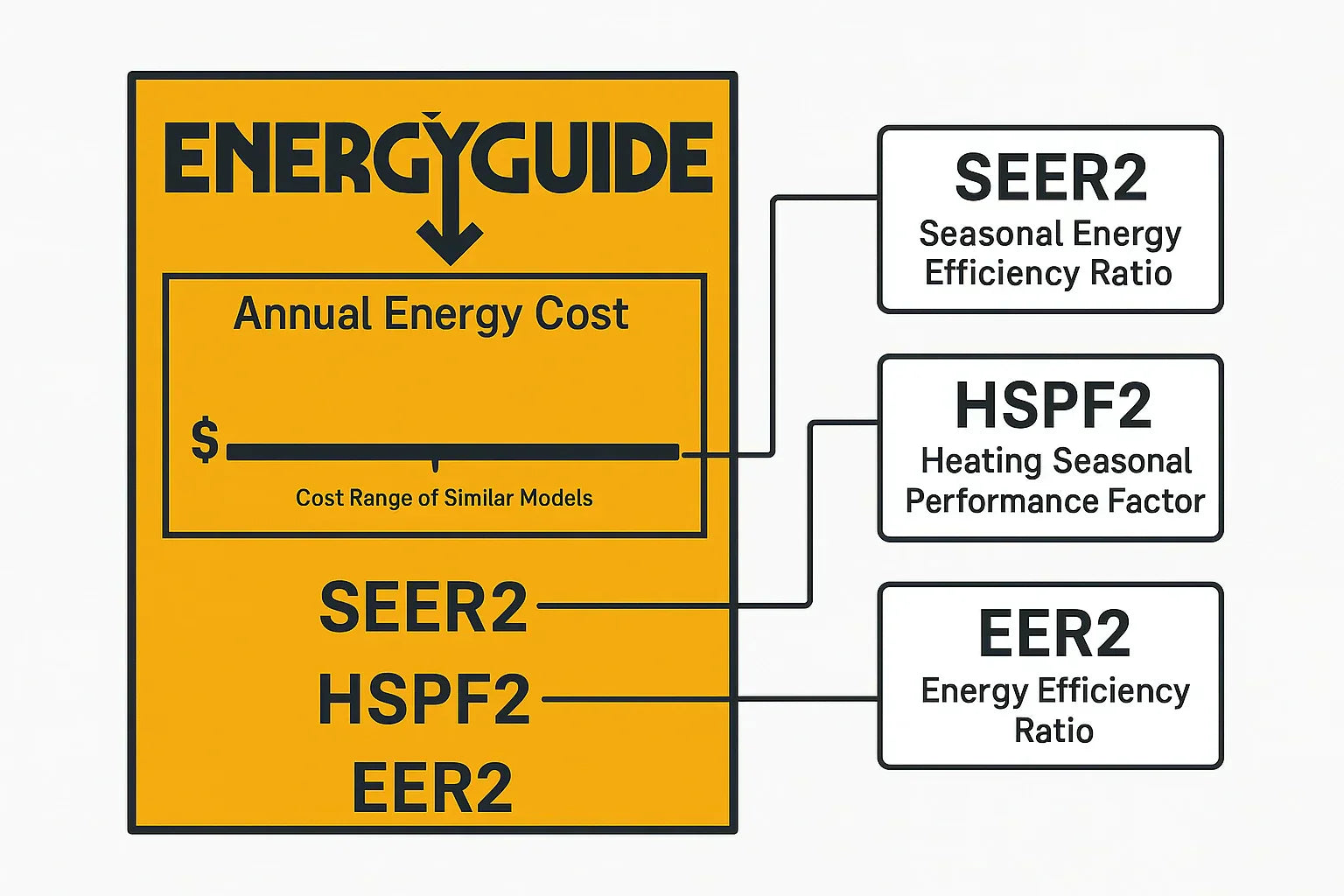If you’ve been shopping for a new HVAC system, chances are you’ve run into acronyms like SEER2, HSPF2, and EER2. They’re plastered on EnergyGuide labels, rebate forms, and manufacturer spec sheets — but most homeowners don’t really know what they mean.
And that’s a problem, because choosing the wrong rating to prioritize can lead to higher energy bills, uncomfortable indoor temps, and missed rebate opportunities.
So in this guide, I’ll break down what each metric actually measures, how they compare, and — most importantly — when and where they matter most.
Why These Ratings Matter
HVAC efficiency ratings aren’t just technical jargon. They impact:
-
How much electricity your system uses
-
What kind of rebate or tax credit you qualify for
-
How well your home stays comfortable in extreme weather
-
Your long-term operating costs
When you understand what SEER2, HSPF2, and EER2 are really telling you, you’ll make better decisions — not just for your wallet, but for your home’s year-round performance.
🔗 What is SEER2 and Why It Matters
What SEER2 Measures — and Why It’s the New Standard
SEER2 = Seasonal Cooling Efficiency
SEER2 (Seasonal Energy Efficiency Ratio 2) is the updated version of SEER, used to rate cooling efficiency in both central air conditioners and heat pumps.
It estimates how much cooling a system provides per unit of electricity used over a full summer season — factoring in realistic conditions like external static pressure from ducts.
-
Higher SEER2 = better cooling efficiency
-
Typical range (2025): 13.4 to 21+ SEER2
When SEER2 Matters Most
-
If you live in hot or mixed climates
-
If cooling costs make up the bulk of your utility bill
-
When comparing central AC units or heat pumps in cooling mode
What HSPF2 Measures — and Why It’s Critical for Heating
HSPF2 = Seasonal Heating Efficiency
HSPF2 (Heating Seasonal Performance Factor 2) is the updated version of HSPF and is used to measure heating efficiency for heat pumps. It tells you how many BTUs of heat you get for every kilowatt-hour of electricity used during the heating season.
-
Higher HSPF2 = more efficient heating
-
Typical range: 7.5 to 10.5 HSPF2 (2025)
📘 ENERGY STAR – Heat Pump Ratings
When HSPF2 Matters Most
-
If you’re using a heat pump as your primary heating source
-
If you live in cool or cold climates
-
When evaluating winter performance and potential savings
What EER2 Measures — and Why It Complements SEER2
EER2 = Peak Cooling Efficiency
EER2 (Energy Efficiency Ratio 2) is the instantaneous cooling efficiency of an HVAC system under fixed conditions — specifically at 95°F outdoor temperature and 80°F indoor temp.
Unlike SEER2, which averages performance over an entire season, EER2 is more like a stress test — it shows how well your system performs during extreme heat.
📘 California Energy Commission – EER Explained
When EER2 Matters Most
-
If you live in very hot climates (e.g., Arizona, Nevada, Texas)
-
If your AC runs hardest during peak hours
-
If you want better insights into summer load performance
How the Three Metrics Work Together
SEER2, HSPF2, and EER2: A Full Efficiency Profile
| Metric | Measures | Mode | Best for |
|---|---|---|---|
| SEER2 | Seasonal cooling | Cooling | Hot/mixed climates |
| HSPF2 | Seasonal heating | Heating | Cold/mixed climates |
| EER2 | Peak cooling | Cooling | Hot climates/extremes |
Each rating tells part of the story. When you look at all three together, you get a clearer picture of how your system will perform year-round, not just on paper.
📘 ENERGY STAR – AC & Heat Pump Criteria
Which Ratings Should You Prioritize?
Here’s a simple way to choose which efficiency ratings matter most — based on your climate zone and HVAC goals:
🔥 Hot Climate (e.g. Florida, Arizona)
-
Prioritize SEER2 and EER2
-
Look for SEER2 ≥ 16.5 and EER2 ≥ 12
❄️ Cold Climate (e.g. Minnesota, Maine)
-
Prioritize HSPF2
-
Look for HSPF2 ≥ 8.5 with backup heating planning
🌤️ Mixed Climate (e.g. Pennsylvania, North Carolina)
-
Look for balance across all three
-
SEER2 ≥ 15.2, HSPF2 ≥ 8.0, EER2 ≥ 11.5
📘 ENERGY STAR – Most Efficient 2025 Models
Don’t Make the Mistake of Shopping on SEER2 Alone
Many homeowners (and some contractors) focus too much on SEER2 when comparing HVAC systems. But a unit with a great SEER2 rating and poor EER2 or HSPF2 might underperform in your actual climate.
For example:
-
A heat pump with 18 SEER2 but 7.5 HSPF2 might disappoint in winter
-
A system with high SEER2 but low EER2 may struggle during extreme heat
Smart shopping means understanding what your home needs most — and matching it to the right mix of ratings.
Final Thoughts: Know the Ratings, Own the Results
SEER2, HSPF2, and EER2 may seem like alphabet soup at first — but they each play a unique role in HVAC efficiency. Together, they help you:
-
Predict utility costs more accurately
-
Qualify for the best rebates and tax credits
-
Choose a system that keeps your home comfortable, year-round
Efficiency isn’t just about saving energy — it’s about choosing a system that works smart, lasts long, and performs well in your unique environment.
👉 Next in the Series: How SEER2 Ratings Impact Your HVAC System’s Sizing
Alex Lane
Your Home Comfort Advocate







